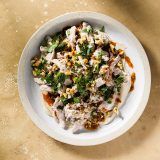In 1971, I traveled to Istanbul and found a city that retained hints of its past, from the rug sellers in the Grand Bazaar to the Basilica Cistern to games of sidewalk backgammon played while sipping hot sweet tea.
I returned 50 years later and found a different Istanbul—modern, bustling with 15 million people and traffic that makes Los Angeles look provincial. But many of the street vendors provided the local flavor I was looking for, including two sandwiches of note: one made from griddled mackerel and the other from chopped and spiced lamb intestines.
But to get beyond first appearances, Ana Sortun—chef/owner of Oleana restaurant in Cambridge, Massachusetts, which specializes in Turkish food—offered to be my guide, having visited Turkey over 30 times in half as many years.
She gave me the cook’s tour, which took us to Haci Bekir, famous for their Turkish delight; the remarkable Çiya Sofrasi (on the Asian side of the Bosporus in Istanbul); and a lunch at Tarihi Nato Lokantasi, a workingman’s lunch spot where the food (including Lady’s Thighs, a form of kofte, and a five-star rice pudding) is served quickly—a Turkish version of fast, but good, food.
The highlight of the trip, however, was a visit with the extended family of chef Cagla Gurses. In their home kitchen, Emine Nese Daglar (Gurses’ grandmother), Turkan Karagozoglu and other family members showed me how to make Turkish classics, including Circassian chicken (çerkez tavuğu, or chicken with walnuts), red lentil soup, and a wedding soup that starts with lamb necks prepared in a pressure cooker.
Circassians originated from a mountainous region in southern Russia. Driven out of their homeland in the 1800s, many Circassians relocated to what was then the Ottoman Empire; some were installed at the palace. And they brought their distinctive cooking techniques with them. As a result, Circassian chicken became part of palace cuisine, a style of refined dining associated with royalty. Originally a main course, today it often is served as an appetizer or meze.
The recipe starts by poaching chicken (two whole breasts and two whole legs) in water. The poaching liquid is strained and reserved. Pieces of bread are moistened with the liquid and blended with walnuts and a little more liquid to form a paste-like sauce.
To assemble the çerkez tavuğu, the thick paste is set into the bottom of a serving dish, followed by a layer of chicken. For serving, it gets drizzled with olive oil infused with flakes of the dried red pepper referred to as maras biber (similar to Aleppo pepper and the go-to pepper in Turkey).
It’s the Turkish version of chicken salad, rich with ground walnuts, smooth with bread paste and slightly spiced with the maras biber. Traditionally, this was a time-consuming dish, the walnuts being mashed with a mortar and pestle until the oils separated, giving this dish its singular unctuousness. But with a food processor, it’s nearly effortless.
Çerkez tavuğu is a good example of Turkish cooking, since it is based on a marriage of simplicity and flavor. This was even true of the best Ottoman cuisine. This simplicity belies the sophistication of Turkish palace food and its unique juxtaposition between East and West. It doesn’t have to be elaborate; it just has to be good.
The Sultan’s Chicken Salad
Istanbul street vendors offer breads such as simit for breakfast.
Photo: Christopher Kimball; Connie Miller of CB Creatives; Styling: Christine Tobin







